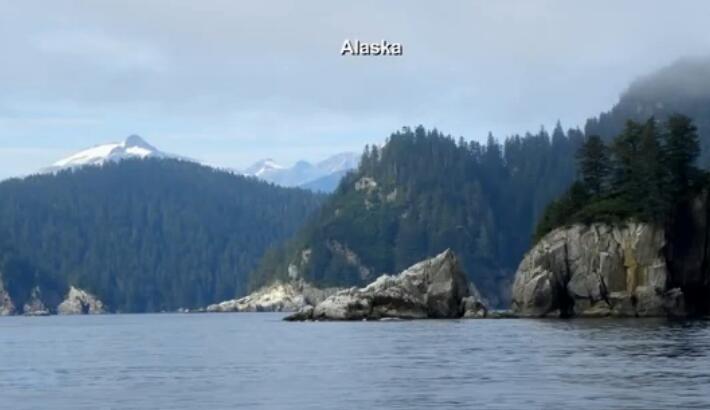Have you ever wondered how the rapid warm-up in the Arctic and climate change could disrupt winds at high altitudes across the United States, Europe, and Asia? Well, if you're like most people, you probably haven't given it a thought. But as a meteorologist, I'm paying close attention to what's going on because it often leads to weather like this.
你曾想过北极剧烈的暖化和气候变迁可能会怎样扰乱美国、欧洲和亚洲地区高空的风吗?这个嘛,如果你和多数人一样,你大概从来没有去思考过。不过身为一个气象学家,我正密切关注着情况,因为那常会导致像现在这样的天气。
There's no place on Earth where the climate is changing as fast as it is here. You've probably seen pictures like this of Alaskan glaciers. This is 1902; here's the same location now. In this part of Alaska, we're losing ice at a rate of nearly two cubic miles per decade. Not all glaciers are shrinking this fast, but most of them in the mid- and higher-mid latitudes are melting pretty quickly. Here's another one: It's the Muir Glacier in 1941. Here it is now.
地球上没有任何地方的气候变化得和此处一样快。你或许看过像这样的阿拉斯加冰河照片。这是 1902 年的景象;这是同样地点目前的样子。在阿拉斯加的这个地区,我们正以将近每十年两立方英里的速度丧失冰。并非所有冰河都消退得如此快,不过多数在中纬度和高纬度地区的冰河都正颇快速地融化。这里是另一个例子:这是 1941 年的缪尔冰河。这是它现在。

These are maps of the earth's surface temperature anomalies that are variance from normal over the last few decades. Everywhere you see yellow, orange, and red is where the temperature is now averaging above normal. Look at where most of the global warmth is occurring.
这些是地球表面温度异常的地图,那些是和过去数十年来正常温度的差异。你看见呈黄色、橘色以及红色的每个地方就是目前温度平均高于正常的区域。看看全球暖化大多发生在哪里。
As a meteorologist, I am finding this pretty amazing, because the warmth that I'm seeing in the Arctic isn't just at the earth's surface; it's extending thousands of feet up in altitude. So why, though, should the warmth at high altitudes over the Arctic matter to us thousands of miles away farther south across the United States, Europe, and Asia? Well, it's all connected, and I'll show you how.
身为一名气象学家,我发现这颇为惊人,因为我正在观察的北极暖化不只发生在地球表面;它还延伸好几英尺高。然而,为什么北极高海拔发生的暖化会和我们有关系,对往南好几千英里远的美国、欧洲和亚洲的我们有什么影响?嗯,这全都有关联,我来让你看看是怎样。
First, we all know that the sun heats the equator more than at the poles, but what you may not know is because of that difference in heating, the atmosphere is deeper at the equator than it is at the poles, and this is important. That difference in atmosphere depth is what drives winds in the upper atmosphere which travel around the world. Those are the winds that create our weather. They move storms, warm, and cold air masses around.
首先,我们都知道太阳加热赤道比两极来得多,不过你可能不知道的是,因为那加热程度的差异,大气层在赤道比在两极厚,而这很重要。大气层厚度的那种差异驱动了在高层大气层流动于全球的风。那些就是创造出我们的天气的风。它们将暴风雨、暖气团和冷气团四处移动。
When the Arctic is anomalously warm, those winds have to shift south. In effect, the refrigerator door, so to speak, is opened, and the Arctic's warmth spills south, becoming a mid-latitude chill. Not theory, it's measurably happening. We saw some extreme examples of this in the winters of 2010 and 2011: the record cold and snow in Europe; the record cold in Florida. A rapid succession of snowstorms over the eastern part of the United States and historic snows over the Great Lakes are all part of a pattern of record warmth in the Arctic, especially over Greenland and Alaska. This displaces the Arctic weather farther to the South.
当北极异常温暖时,那些风就得往南移。实际上,可说是冰箱门被打开了,而北极的热量散到南方,成为中纬度的寒冷。这并非理论,这是可测量地正在发生的事。我们在 2010 和 2011 年的冬天见识到一些这样的极端例子:欧洲的低温纪录和降雪纪录;佛罗里达州的低温纪录。美国东部接踵而来的暴风雪以及五大湖区历史性的降雪都是北极空前暖化的模式的一部分,特别是在格陵兰和阿拉斯加地区。这迫使北极的天气向南移。
What's meteorologically interesting about this is that the effect is most prominent during the winter. That's when the temperature differences are at their greatest between the equator and the poles. So when the Arctic is anomalously warm, the mid-latitudes across North America, Europe, and Asia often end up like this.
这在气象学上有趣的地方是,这影响在冬季最为明显。冬天是赤道和两极间的温度差异最剧的时节。所以当北极异常温暖时,北美洲、欧洲和亚洲的中纬度地区最后常就会变得像这样。
And, looking into the future, global climate models continue to show change with a steady decrease in Arctic sea ice, a likely result of both warmer temperatures and disruptions in Arctic wind patterns. In the coming decades, climate models also show significant increase in global temperature, especially in the Arctic. But this is an average. As the Arctic warms, there will be disruptions in atmospheric circulation. Some, as we've seen, won't be so warm.
然后,检视未来,全球气候模式持续伴随着北极海冰的平稳减少显现出变化,一个很可能是温度上升和北极风模式扰乱下的结果。在未来几十年,气候模式在全球温度也显示出明显上升,特别是在北极。不过这是一般状况。随着北极变暖,大气环流将会有扰乱情况。有些地区,如我们已经见到的,不会太温暖。
In this video, we've only touched on just one of the many potential impacts a warmer Arctic can have on us as it feeds back into the climate system. The notion that climate change is a good thing and that we're all gonna be basking in warmer weather in the coming decades is most certainly a misunderstanding. As the world continues to warm so unevenly, it seems very likely there's going to be additional disruptions and storm tracks and precipitation across the Northern Hemisphere. Put simply, it probably means that most of us are going to end up with what used to be somebody else's weather.
在这部影片中,我们只触及到暖化的北极可能会对我们造成的许多潜在影响之一,在北极暖化反应到气候系统中时。气候变迁是件好事这样的看法,以及我们所有人在未来数十年将沐浴在更温暖的天气中这种想法,很肯定是种误解。随着世界持续如此不平均地变暖,很可能将会有额外的扰乱以及风暴路径和降雨在北半球发生。简而言之,这或许代表我们大多数人最后将活在以前曾是他人所习惯的气候中。













